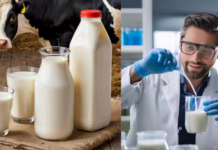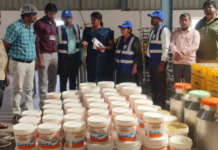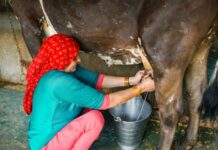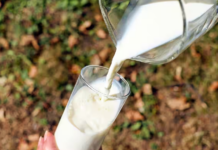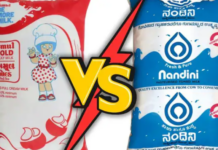While addressing the delegates at the national seminar on “Dynamism in Dairy Industry and Consumer Demands” organised by the SMC College of Dairy Science, Anand Agricultural University in Anand on 4 February 2017, Shri Dilip Rath, Chairman, NDDB said that dairying in India is more about livelihoods to millions of smallholders than simply a business, due to a stable cash flow as compared to crop cultivation and its contribution towards nutritional security for families owning milch animals. Dr NC Patel, Vice Chancellor; Shri RS Sodhi, MD, GCMMF; Dr K Rathnam, MD, AMUL; Dr KB Kathiria, Director, Research and Dean PG Studies, Dr J B Prajapati, Dean Faculty of Dairy Science and Dr Bhadania, President Alumni Association graced the occasion.
Shri Rath said that milk is India’s single largest agricultural commodity in value terms and is more than the combined value of paddy and wheat put together. Milk producing households are predominantly small farmers with less than 2 ha of land and 1 to 2 animals. Ownership of dairy animals is more evenly distributed in India as compared to operational land holdings. India’s model of milk production is based on feeding crops residues and agricultural byproducts and using family labour to add value to resources which otherwise have limited alternative economic value.
He said that as per market research reports, the value of the Indian market for milk and milk products is expected to grow at 15% annually of which the contribution of milk products like cheese, paneer, fermented milk products, butter and ghee would be significant which represents both an opportunity and challenge to our dairy industry. Our efforts are aimed at meeting this growing demand for milk mainly from domestic production to continue to maintain our self-sufficiency and food and nutritional security. Chairman NDDB said that the National Dairy Plan Phase I being implemented by NDDB through a network of End Implementing Agencies (EIAs) with the twin objectives of increasing milk production by increasing productivity and providing market access to milk producers is addressing many of these challenges.
In many of the areas where dairy cooperatives have limited or no presence in spite of immense potential for milk production, private dairy sector have increased their share of the milk business. It is in the interest of producers that they also have access to institutions that are owned and controlled by them, as a deterrent to prevent any adverse impact due to market imperfection. Shri Rath said that NDDB’s wholly owned subsidiary has helped promote five large producer companies in five states. In a short period of five years till March 2016, these five producer companies have enrolled about 3.26 lakh milk producers of whom about 62 percent are small holders and 40 percent are women. These five companies collectively procured about 19.3 lakh kg of milk per day during 2015-16.
Under NDP I, indigenous breed development programmes for selected indigenous dairy breeds are being implemented in their respective native tracts through scientific selection programmes. Due to increased productivity and ration balancing programmes, carbon foot print of milk in terms of kg of CO2 equivalent per kg of Fat and Protein corrected Milk (FPCM) decreased both in cattle and buffaloes over a ten year period ending 2014. These are lower than the corresponding values reported by FAO for South Asian countries.
Considering that energy use is the biggest source of emissions, NDDB has also been encouraging dairies in the dairy cooperative network to adopt renewable energy. These initiatives include use of concentrated solar thermal for preheating of water and solar powered milk collection systems.
Speaking on ensuring food safety and quality, Shri Rath said that this is not only a statutory obligation but also a business imperative for all food business enterprises. Expansion and modernization of milk processing capacity is the most critical element in ensuring food safety and quality as they can help in implementing a scientific Hazard Analysis and Critical Control Point (HACCP) system. Over the years, a little over a lakh electronic milk testing equipment or automatic milk collection units with integration of milk testing and weighing equipment have been installed for fair, quick and transparent milk testing along with integrated recording of all the transactions.
Ensuring hygienic milk handling involves adoption of a cold chain from milk collection point onwards till it reaches the dairy for processing. Over the years, the number of BMCs in the cooperative network has increased to reach a level of about 12,000 units with total chilling capacity of about 315 lakh kg per day by end of March 2016, which includes capacity created under NDP I. This has helped in enhancement of MBRT and hence quality of milk.
Chairman NDDB emphasised that given the likely growth in organized dairy sector, there are opportunities in the areas of a) modernization and expansion of milk processing capacity b) installing equipment for milk cooling at farm level c) developing rapid methods for accurate testing of milk to estimate milk solids content as well as detection of adulteration. The recent announcement in this year’s budget of a Dairy Processing and Infrastructure Development Fund with a corpus of Rs 8000 crore over 3 years will further give an impetus and expand the processing infrastructure.
While the organized dairy sector is the only source for milk powder and condensed milk due to the requirement for specialized equipment at a certain scale, it has managed to gradually increase its market share for items such as liquid milk, ice cream, ghee, curd, milk based beverages, cheese, paneer etc even though the unorganized small scale operators continue to account for a major share, particularly in unpasteurised liquid milk and indigenous dairy based sweets. In case of many traditional indigenous products, a large proportion is still being produced and retailed by the unorganized sector. As widely prevalent nutritional deficiency disorders can be prevented or even reversed with fortification of foods with Vitamin A & D, it represents an opportunity to address health conditions that affect the lives of millions. This sector provides huge opportunity for growth of organized dairy industry in future for which focused and continuous R&D and product development efforts keeping in mind the fast changing consumer preferences, need to be undertaken. Similarly, development of longer shelf life dairy products, specialized dairy based nutraceuticals & wellness products, probiotics catering to different classes of consumers and niche markets needs to be undertaken by the dairy industry particularly by cooperatives to increase realization and for market diversification. NDDB



